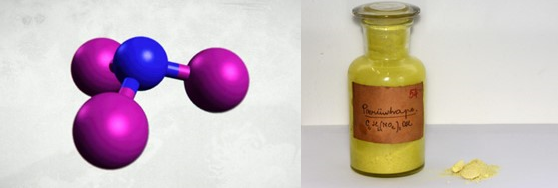Contact explosives : chemistry is a blast!

Contact explosives are a realm of chemistry I find fascinating. What could be more appealing to a budding chemist than something that explodes seemingly just by looking at it?
A contact explosive is a chemical which requires only a small quantity of energy to explode violently. They differ from normal explosives in that simple heating, friction, or exposure to alpha particles or magnetic fields can cause detonation.
A classic example is nitrogen triiodide. The element nitrogen ‘wants’ to be in the stable diatomic form, N2. As a result, nitrogen-based compounds can be very unstable, easily breaking apart and releasing N2 in the process.
Nitrogen triiodide (NI3) has three large iodine atoms, all bonded to one small nitrogen atom. Nitrogen itself has five electrons, three of which are used in bonding to the iodine atoms. The remaining pair of electrons repel the iodine atoms, forcing nitrogen triiodide into a congested pyramidal shape. The nitrogen-iodine bonds are under tremendous strain and easily snap, releasing a cloud of nitrogen and iodine gas.
This reaction, the decomposition of nitrogen triiodide, is particularly beautiful to behold, and one I have used when teaching chemical bonding to my pupils.
To prepare this reaction requires the use of concentrated ammonia solution and iodine[1]. Adding them together then leaving them out to dry yields a dark purple, almost black solid material. Gently stroking it with a feather results in an incredibly loud bang, a thick cloud of purple smoke, and (in my experience at least) a shrieking technician. Failure to properly clean your experimental area afterwards will lead to numerous smaller, but just as loud, random detonations occurring throughout the rest of the day as the remains continue to pop.
Contact explosives can be formed accidentally too. Picric acid — historically used as a component in biological sample preservatives and medical kits[2] — becomes very unstable when dried out. When clearing out old specimens, one university found a jar containing a frog, pickled using picric acid. The solvent had evaporated, leaving the frog coated in picric acid crystals. One slight knock could have resulted in the detonation of the amphibian and the destruction of a large portion of the lab. Museums and high school labs have even called in bomb disposal teams to remove specimens containing it.
Contact explosives are a blast. They go boom with the tickle of a feather and are not for the faint of heart or clumsy of hand. Moreover, they present exciting demonstrations of the energy trapped within chemical bonds.
[1]https://edu.rsc.org/exhibition-chemistry/nitrogen-triiodide-a-sensitive-contact-explosive/2020065.article
[2]https://www.stuff.co.nz/national/125677951/potentially-explosive-substance-was-in-catlins-museum-for-decades
Edited by Hazel Imrie
Copy-edited by Rachel Shannon







